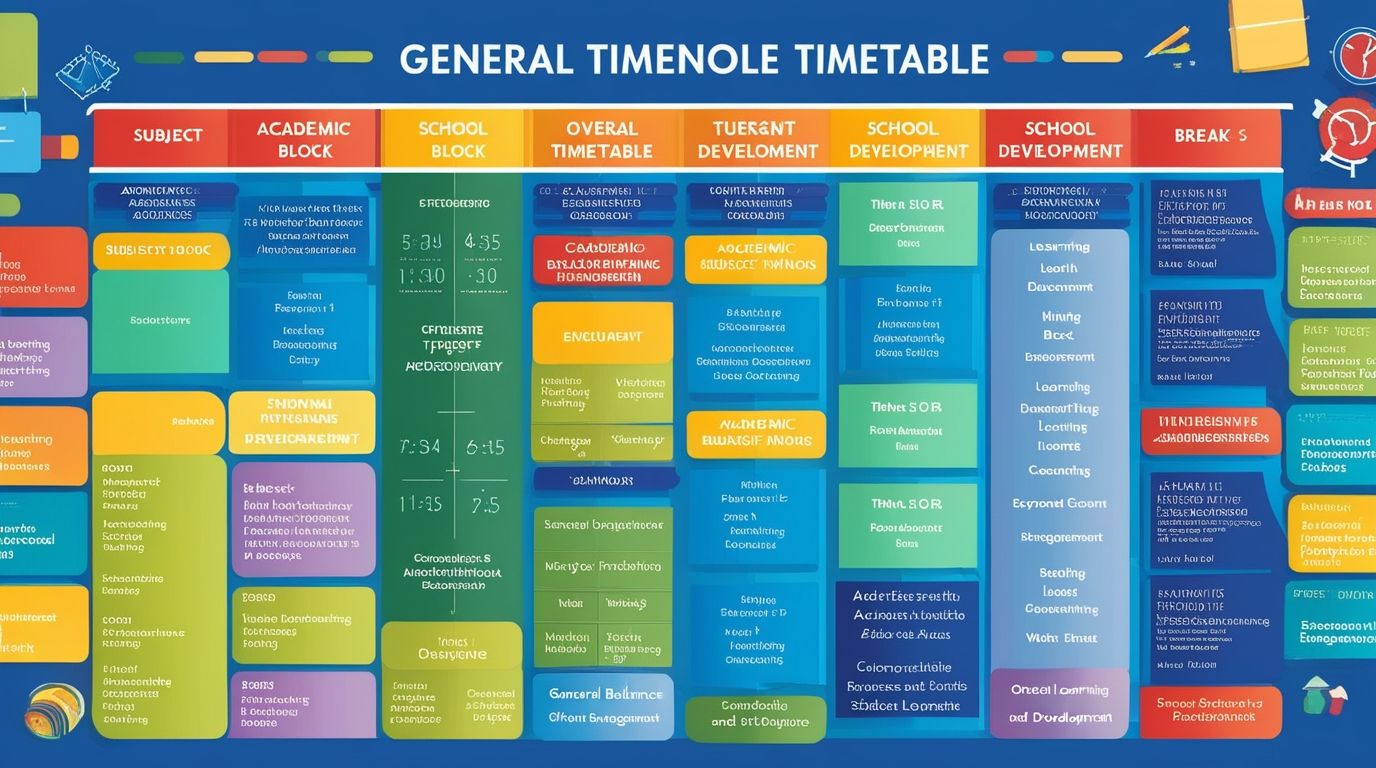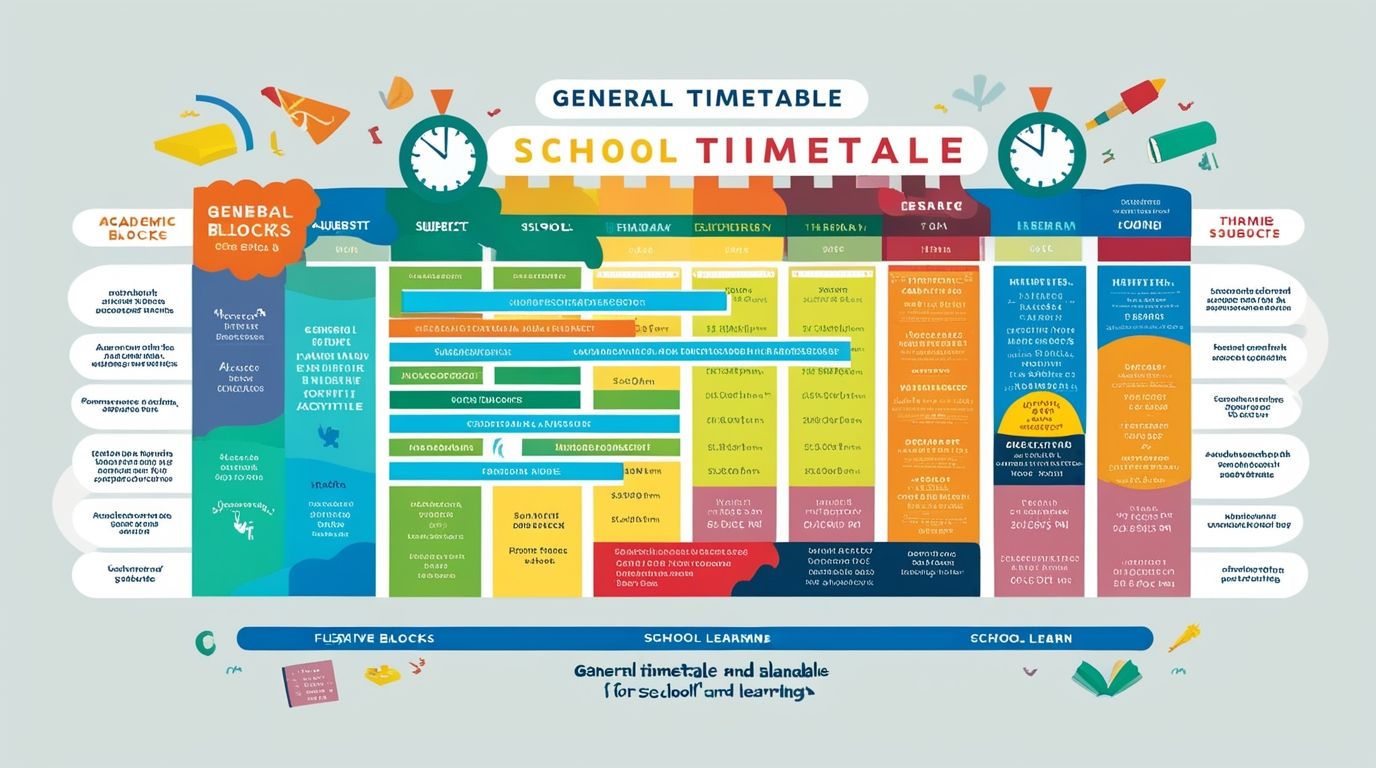Introduction
General Timetable for School and Learning, A well-structured timetable is essential for effective learning and personal growth. It provides a framework for managing time, balancing various activities, and achieving academic and personal goals. This article explores a creative approach to designing a general timetable for school and learning, offering flexibility and adaptability to cater to different learning styles and needs.
1. Understanding the Basics
A creative general timetable should not be a rigid schedule but rather a flexible guide that accommodates the diverse needs of students. It should incorporate time for academic subjects, extracurricular activities, personal development, and rest. The goal is to create a balanced approach that promotes overall well-being and fosters a love for learning.
2. Core Components of a Creative Timetable
A. Academic Blocks
- Subject Time Allocation: Divide academic subjects into blocks based on their complexity and the time needed for effective learning. For example, allocate more time to challenging subjects and less to those that are easier.
- Varied Learning Activities: Incorporate different types of learning activities within each subject block, such as lectures, discussions, hands-on activities, and multimedia resources. This keeps students engaged and caters to various learning styles.
B. Extracurricular Activities
- Diverse Interests: Schedule time for extracurricular activities such as sports, arts, music, and clubs. This helps students develop a well-rounded skill set and explore interests outside of academics.
- Balance and Variety: Ensure that extracurricular activities are varied and balanced throughout the week to avoid burnout. For instance, alternate between physically demanding activities and creative pursuits.

C. Personal Development
- Self-Reflection Time: Include time for self-reflection and goal setting. This could be a weekly review session where students assess their progress, set new goals, and reflect on their achievements.
- Skill Development: Allocate time for developing soft skills such as time management, communication, and problem-solving. These skills are essential for personal and professional growth.
D. Rest and Recreation
- Scheduled Breaks: Incorporate regular breaks to prevent fatigue and enhance productivity. Short breaks between study sessions can improve focus and retention.
- Leisure Time: Schedule leisure activities that students enjoy, such as reading for pleasure, hobbies, or spending time with family and friends. This helps in maintaining a healthy work-life balance.
3. Implementing Flexibility
A. Adaptability
- Adjustable Blocks: Design the timetable with adjustable blocks to accommodate changes in workload or personal needs. For instance, allow for flexibility in subject study times based on upcoming exams or projects.
- Personal Preferences: Allow students to choose their preferred times for studying different subjects or engaging in activities. This can enhance motivation and make learning more enjoyable.
B. Incorporating Technology
- Digital Tools: Use digital tools and apps to create and manage the timetable. Tools like Google Calendar, Trello, or Microsoft OneNote can help students organize their time effectively and set reminders.
- Online Resources: Integrate online learning resources and platforms into the timetable. This can provide additional support and enrichment opportunities beyond traditional classroom learning.
4. Creating a Sample Timetable
There would be different samples you should select your own contexual needs and time
5. Tips for Success
- Regular Review: Regularly review and adjust the timetable based on progress and changing needs. Flexibility is key to maintaining effectiveness.
- Feedback and Improvement: Seek feedback from students and parents on the timetable’s effectiveness and make improvements as needed.
- Encouragement and Support: Encourage students to stick to the timetable and provide support when they face challenges. Celebrate achievements and milestones to keep motivation high.
Conclusion
A creative general timetable for school and learning is more than just a schedule; it’s a tool for fostering a balanced, engaging, and productive learning environment. By incorporating academic blocks, extracurricular activities, personal development, and rest, and allowing for flexibility, students can manage their time effectively and enjoy a well-rounded educational experience. Remember, the key to a successful timetable is adaptability and personalization, ensuring that it meets the unique needs of each student while promoting overall well-being and growth.

9 thoughts on “General Timetable for School and Learning”
Comments are closed.